“I have long wanted to learn how to grow roses from given bouquets. I just can’t bring myself to throw away fading flowers. I always try to take cuttings from them, but not a single cutting has ever taken root. I do everything strictly according to the rules, follow all the recommendations and no results. Is it even possible to grow roses from a bouquet?”
Lena. 28 years old Saratov.
If Lena had written how and under what conditions she tries to grow her roses, it would have been much easier to answer. But I think that this question interests not only Lena from Saratov, but also many other girls and women who are given these beautiful flowers.
This is especially true in mid-March, when the roses given for the holiday begin to fade. Looking ahead a little, I can please the owners of 8 March bouquets - cutting roses in March has every chance of success.
- At this time, nature begins to awaken.
- Before the holiday, flowers are quickly sorted out, they don’t last long in the store, where they are stuffed with all sorts of “chemicals”
- Roses given with such love are simply bound to please you not for a few days, but for many, many years.
This is of course the lyrics, but as for the main question:
“Is it possible to grow roses from a bouquet at home?” - yes, it is possible, but the percentage of rooted cuttings, as a rule, is not high.
Which one? Very different. It depends on the specific conditions
- When you were given a bouquet of roses. In spring, summer - good. In autumn and winter - not so much.
- Local roses are excellent, imported ones are worse.
- The flowers stood in the store for a long time - they were bad; they were sold quickly - and that was better.
- And finally, how good are you at taking plant cuttings?
But even if you have never been involved in growing roses from cuttings, it doesn’t matter, it’s not at all difficult to learn, and you don’t need any special knowledge for this.
I just want to warn you against disappointment and warn you right away: Even for people with experience, not everything always goes smoothly and the results can vary greatly from year to year.
Below we will talk about why this happens.
Optimal conditions for rooting cuttings
For rooting to be successful, you must try to create the most favorable conditions for the cuttings. There are not many requirements. Here are the three main ones:
- Optimal temperature within + 25º. I think everything is clear with this point.
- Humidity 80 - 90%. Humidity is determined quite simply. Rose cuttings are grown under film cover or under jars; if the film is foggy from the inside, then the humidity is normal; if it is dry, it’s time to water.
- Neutral, poor soil. The easiest option when growing roses in open ground is to mix soil with sand in a 1:1 ratio. Just don’t try to add manure or compost. These adult roses love manure fertilizers, and cuttings from such additives can rot. In winter, cuttings can be carried out in peat, in peat mixed with sand, in perlite, vermiculite (vermiculite is preferable), in coconut fiber, or, as in summer, in soil with sand. In addition, you can use sphagnum moss.
Fulfillment of these conditions is quite sufficient for rooting cuttings.
You've probably heard other tips and tricks that should have a positive impact on the outcome of your case, but in practice, most of them either have minimal impact or are completely useless. I mean the following tips:
- “You need to cut the leaves by half or 1/3” This action does not affect the germination of roots in any way; you can cut them or leave them whole. The only thing you need to know and follow is that when cuttings in the light, leaves are needed, and when germinating in the dark (for example, using the buritto method), the leaves need to be cut off. Sometimes I cut plants in an aquarium and shorten the leaves there so that they don’t puff up, but this is only to save space.
- “Use Kornevin or some other root-forming preparation” I repeatedly conducted unplanned experiments, dusted one batch of cuttings with root, and simply forgot to do it on the other. Thus, I had the opportunity to make sure that these preparations do not have any noticeable, positive effect on growing roses from cuttings (may the manufacturers of these powders forgive me).
- “Deep the cutting into the ground 1 - 1.5 cm.” In my opinion, shoots buried 5 - 7 cm take root, if not better, then at least no worse, but working with them is much easier. Chibouks stuck 1 cm into the ground fall off with the lightest touch. Especially if their spines are not cut, which tend to get caught on everything.
- “Make the bottom cut at an angle of 45º, and the top at an angle of 90º.” Make the bottom cut immediately under the bud, always with a sharp tool, and at what angle it will be made is absolutely not important.
It is recommended to make the lower cut at an angle of 45º to increase the cutting area. It is at this place that callus then forms, and people probably think that the larger the area of the callus, the more roots it will grow. The most important thing is that the callus simply forms, and the roots will grow, you can be sure.
But to increase the number of roots, I can recommend a more effective method. Callus, and then roots, appear on the injured parts of the stem, so several small wounds can be made on the part of the shoot that will be in the ground.
I usually remove all the thorns on the cuttings. On the above-ground part I cut it off with pruning shears, and on the part that will be in the ground I break it down to the base and a wound is formed in this place.Roots almost always grow from these wounds.
The photo, unfortunately, is not of high quality, but I think it is clear that in place of the broken thorn an impressive callus has formed, from which roots will soon appear. I grew these cuttings in perlite, so they are so clean and everything is clearly visible.
Now let's talk about the most important thing: how can we learn to grow roses from presented bouquets?
The thing is that bouquets of roses are given throughout the year. And cuttings of roses in summer and winter, for obvious reasons, are very different. Therefore, each option will have to be considered separately, that is, seasonally.
How to grow roses from a given bouquet in the summer
In the warm season, the easiest way to grow a rose from a bouquet is in the open ground, in the garden. The best time for this is April, May, June, July. Later, there is no point in planting cuttings in the ground.
In order for young roses to bloom next year, it is not enough to root them, they also need to be overwintered, and this is also not an easy task. Roses rooted in summer do not have time to grow a sufficiently powerful root system before autumn and therefore they do not survive the first winter well.
If a cutting from a bouquet planted in spring or early summer quickly took root and began to grow, then it can be left to overwinter in the garden. Of course, it should be covered warmer than adult rose bushes. It is best to cover it with leaves, grass, and cover it with lutrasil on top.
It makes no sense to leave stems of roses planted in the middle of summer, and even those that have not sprouted immediately, in the garden for the winter. They will surely die. Such specimens will have to be dug up and replanted in pots at the beginning of October, and with the onset of frost they will have to be placed in a cellar or room with similar conditions.
Attempts to winter at home, on the windowsill, rarely end successfully. Even if the roses grow, they are frail, elongated, and most often they die.
Preparing cuttings from a bouquet for planting
Since we will be cutting the stems from the flowers that were in the bouquet, we need to carefully examine the stem and select fragments where there are three healthy, living buds in a row. The stem itself should not be wrinkled or blackened by water.
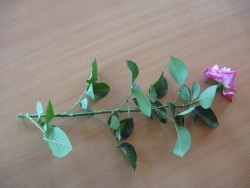 |
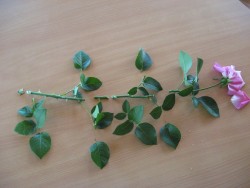 |
Using a sharp knife or pruning shears, cut out a fragment of the stem with three buds. Make the lower cut directly under the bud, and the upper cut 1 cm above the bud. Remove the bottom sheet and the preparation can be considered complete.
Decide for yourself whether to use root or heteroauxin or not. As I already wrote, there is not much use from them, but there is no harm either
Soil for planting
In the place where you will grow roses, add sand and dig up the soil so that the ratio of sand to soil is approximately 1:1
What to make a greenhouse from
It is very practical to cover the roses with cans or cut plastic bottles (5 liter). Throughout the summer, the jars do not need to be removed or lifted. Even leave the plant to overwinter under these jars and bottles, just cover it additionally on top.
Water also between jars, and monitor the humidity by the presence of evaporation on the glass. If the glass is fogged up, it means it’s too early to water.
Choosing a place to grow roses
It is most convenient to place the cuttings somewhere under the trees so that the sun hits them only occasionally.
In general, summer cuttings of roses in the garden very much, if not entirely, depend on the weather. As you know, the optimal temperature for cuttings is 24 - 26º.But if in the summer in the shade, in Saratov for example, it is +40º, then how much is under the can, and if the sun is also shining on it!
A rainy and cold summer will also be a test for young plants. But even under such extreme conditions, some cuttings still take root and grow no matter what. But in favorable weather the yield can be up to 100%, and in unfavorable weather up to 10%
Cuttings of bouquet roses in autumn
Reproduction of roses in autumn video part 1:
From August to March, rooting roses from bouquets is carried out at home on the windowsill. It must be said right away that it is very difficult to grow roses from a bouquet in the fall and in the first half of winter.
Plants at this time are in a state of rest and stirring them up and making them grow is quite a difficult task.
The exception is homemade, miniature roses, which are successfully grown from cuttings both in autumn and winter. But this is not our case, at the moment we are interested in bouquet roses, and with them everything is not so simple (although not hopeless).
However, it is in the fall that it is possible to successfully root roses and many other plants. The method is very effective and at the same time simple. True, it can only be used from the beginning of October until the onset of frost.
During this month, the cuttings are planted not at home in cups, but in the garden directly into the ground, and here they will overwinter.
Preparing planting material
Chubuki for winter planting are prepared a little longer than in summer, with 3-4 internodes (an internode is the part of the stem from bud to bud).
The leaves are not needed; carefully trim them with pruning shears, being careful not to damage the buds.
Landing place
A buried greenhouse is an ideal place for planting.
Landing
Stick the cuttings into the ground at an angle of 45º, leaving two buds on top. After planting, water and sprinkle lightly with leaves to retain moisture. All accepted roses (and up to 90% are accepted) will grow in this greenhouse next summer and overwinter the following winter, so plant less often to avoid crowding. Only after a year, the grown and strengthened plants are planted in flower beds.
Shelter for the winter
Before frost, fill the greenhouse to the top with leaves and cover with lutrasil
Important! To prevent the greenhouse from being flooded with water during winter thaws and spring, make high earthen sides around it. At the same time, the soil in the greenhouse should be moist even in winter; you should not cover it with slate.
What to do in spring
With the arrival of spring, remove the lutrasil, remove most of the leaves (leave a little for moisture retention), install arcs and stretch the film. In the future, monitor the temperature and shade if necessary. When young shoots begin to grow and it becomes clear that the plants have taken root, begin to gradually ventilate the greenhouse.
For ventilation, it is safer not to lift the edges of the film from below, but to make small holes in the film from above. Gradually increasing the size and number of holes. When the film is completely torn, it can be removed.
This method is much more gentle for young and tender shoots. If you simply lift the edges of the film, you may not be able to keep track of the rising wind; if it does not tear off the cover, it may simply “burn” the pampered leaves and the plants will die. Such an annoying little thing can ruin the whole thing!
Reproduction of roses in autumn video part 2
Is it possible to root flowers from a bouquet in winter?
Most likely nothing will happen until the New Year. But from mid-January the chances will increase every day.
But if flowers have already been given to you and you still have nothing to lose, try growing them at any time. Here we need to talk about one more “factor”. Don’t make fun of me, but there are people with a “light hand” and others with a “heavy hand”. Some stick a stick into the ground and it takes root, while others fight and fight, all in vain.
In winter, roses are grown at home in several ways.
- in the ground
- in water
- in damp paper or cloth
The principle of all these methods is the same - the cutting should be in a moderately humid, warm environment.
Cuttings in the ground
The shoot for cuttings is prepared in the same way as in the summer. It should consist of two internodes with three living buds.
Above I have already listed which substrates are best to use as soil. Of all the ones listed, I like vermiculite best, but all the others are also suitable.
Preparing for landing
- Be sure to make drainage holes in the cup.
- Pour vermiculite into a glass and place it in a container of water to thoroughly wet the vermiculite.
- Remove the cup and wait until excess water drains through the holes.
- Insert the cutting so that the middle bud is slightly above the vermiculite level.
- Cover the glass with a plastic bag and place it on a window or under a lamp.
Keep in mind that in winter the humidity should be kept somewhat lower than in summer.. If in summer there should be perspiration on the glass, then in winter in such conditions the shoot may rot.
Vermiculite is good for everyone, but it also has a drawback - after the roots grow, the young rose will have to be transplanted into a pot with soil.To save yourself from double work, immediately prepare a pot of soil (it’s better to buy soil at a flower shop).
In the spilled, wet soil, make a depression 3 cm wide and 5 - 6 cm deep, fill it with vermiculite and stick the cutting there. Now the rooted shoot will not need to be disturbed once again by transplanting. It will immediately grow in a permanent place.
A very useful and informative video about growing bouquet roses. I recommend watching it.
Rules for rooting roses in water
- Find dishes made of dark glass or plastic.
- Use only boiled water (you can add one tablet of activated carbon to the water)
- Pour a little water, the layer of liquid should not exceed 2 - 3 cm.
- Do not change the water, but only add the same boiled water as it evaporates.
- Place the cuttings in water and wait for roots to form.
- When roots appear, transplant the plant into the ground.
Sometimes it takes a long time to wait for callus and roots to form (up to two months).
If the stem is green, it means it is alive, but when it starts to turn black, then it’s bad - you can throw it away.
The second method of rooting in water
This method is longer and more complex, but experts say it is much more effective. You've probably noticed that if you don't throw away a wilted bouquet of roses for a long time and continue to keep it in water, then young shoots begin to grow from the buds.
Roots rarely form, but shoots almost always grow. So these young shoots are used for cuttings. You just need to wait until they turn from reddish to dark green (for this, the bouquet must be in the light, otherwise they will never turn green). Then cut them off with a blade or a very sharp knife and place them in water as described above.
To speed up the appearance of such shoots in a bouquet that has lost its decorative effect, cut off the flowers and cover with a transparent bag. Just remember to keep an eye on the appearance of shoots. The shoots cannot be cut off ahead of time, but they also cannot be left too long; they grow quickly and wither just as quickly.
Growing roses in winter using the buritto method
Using this method, shoots for germination are prepared longer, with 5 - 6 buds. They will germinate in the dark, so the leaves are not needed and must be removed.
Wrap the prepared chibuki in damp newspaper or cloth and place in a plastic bag. The package should be kept in a moderately warm place. At least once a week, unwrap it and check the condition of the cuttings.
The main problem you may encounter is rotting and mold on the stems. The main thing here is not to overdo it with humidity. You can wrap the cuttings not completely, but leave the top open, but then you may have to spray them from time to time.
Overall this is a good, productive method. Garden roses, especially climbing ones, are easy and convenient to grow in this way. But bouquets, which have been treated in stores with all kinds of preservatives, do not behave predictably.
The only good news is that the March 8 bouquets do not sit in stores and do not have time to absorb a lot of chemicals.
And one last tip:
Grow our local roses from bouquets. The imported ones are of course beautiful, but they don’t spend the winter here and don’t live in indoor conditions.
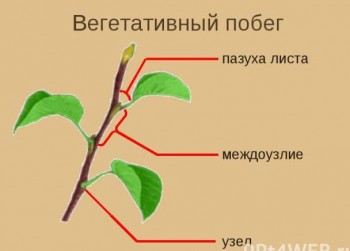

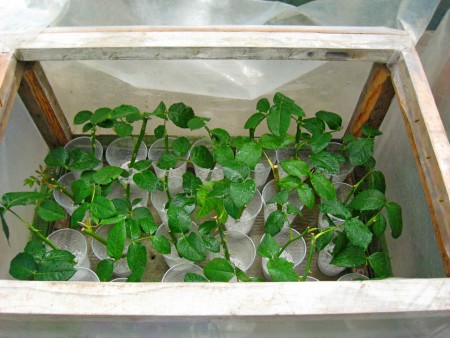
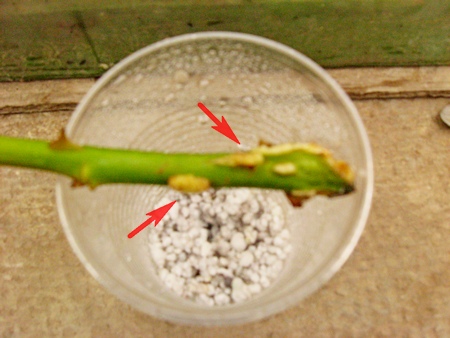
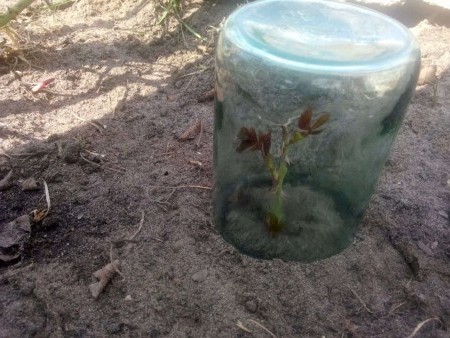
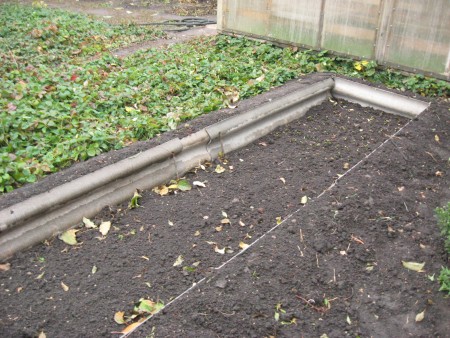

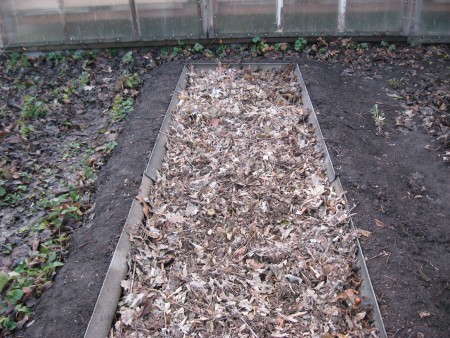
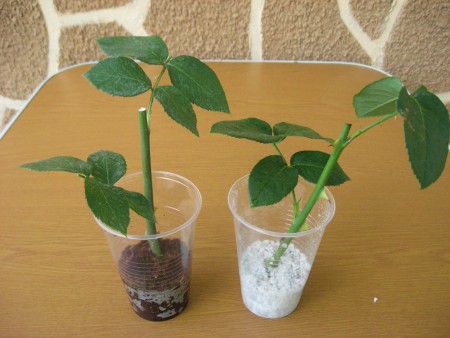
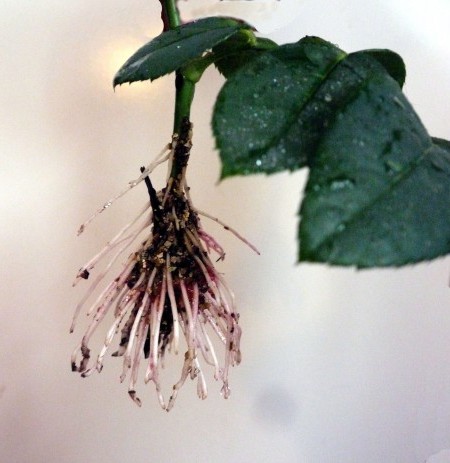
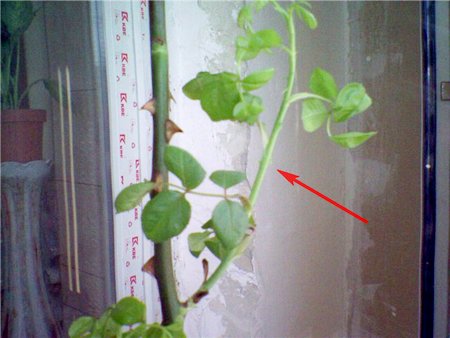

 (26 ratings, average: 4,46 out of 5)
(26 ratings, average: 4,46 out of 5) CUCUMBERS NEVER GET SICK, I'VE BEEN USING ONLY THIS FOR 40 YEARS! I SHARE A SECRET WITH YOU, CUCUMBERS ARE LIKE THE PICTURE!
CUCUMBERS NEVER GET SICK, I'VE BEEN USING ONLY THIS FOR 40 YEARS! I SHARE A SECRET WITH YOU, CUCUMBERS ARE LIKE THE PICTURE! You can dig a bucket of potatoes from each bush. Do you think these are fairy tales? Watch the video
You can dig a bucket of potatoes from each bush. Do you think these are fairy tales? Watch the video
 How our fellow gardeners work in Korea. There is a lot to learn and just fun to watch.
How our fellow gardeners work in Korea. There is a lot to learn and just fun to watch. Eye trainer. The author claims that with daily viewing, vision is restored. They don't charge money for views.
Eye trainer. The author claims that with daily viewing, vision is restored. They don't charge money for views. A 3-ingredient cake recipe in 30 minutes is better than Napoleon. Simple and very tasty.
A 3-ingredient cake recipe in 30 minutes is better than Napoleon. Simple and very tasty. Therapeutic exercises for cervical osteochondrosis. A complete set of exercises.
Therapeutic exercises for cervical osteochondrosis. A complete set of exercises. Which indoor plants match your zodiac sign?
Which indoor plants match your zodiac sign? What about them? Excursion to German dachas.
What about them? Excursion to German dachas.